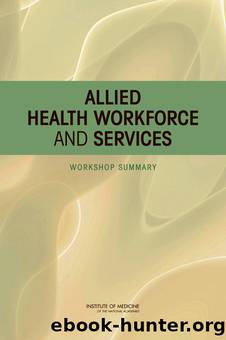Allied Health Workforce and Services: Workshop Summary by Steve Olson

Author:Steve Olson
Language: eng
Format: epub
Tags: ebook, book
ISBN: 0309220629
Publisher: The National Academies Press
Published: 2012-11-29T00:00:00+00:00
COMMUNITY COLLEGES AND THE EDUCATION OF ALLIED HEALTH PROFESSIONALS IN RURAL AREAS
The RHRC at the University of Washington, with support from the Health Resources and Services Administrationâs Office of Rural Health Policy, has been studying
⢠why community colleges are important to the allied health workforce and to rural communities,
⢠which allied health occupations are most relevant to rural areas and can be educated in community colleges,
⢠how many allied health programs are (and are not) located within commuting distance of rural populations, and
⢠how many small rural hospitals are located near allied health education programs.
The yet-unpublished study has drawn expert input from the American Association of Community Colleges, the National Network of Health Career Programs in Community Colleges, and the Rural Community College Alliance. Its main data source has been the U.S. Department of Educationâs Interdisciplinary Postsecondary Education Data System, and it has used definitions of allied health programs from the U.S. Department of Educationâs Classification of Instruction Programs.
Community colleges are extremely important to rural economic development, said Skillman, and in many rural communities they are the only higher education institutions accessible to their populations. âThey work generally with their communities, so to the extent to which rural folks can train in their own communities, it will greatly increase the likelihood that they will work in those communities,â said Skillman. Furthermore, many students in allied health education programs can be job ready after completing community college programs. For this reason, many rural health care programs use a âgrow your ownâ approach. They attract people from rural areas and train them in rural areas to increase the chances that they will stay in those areas.
Skillman and her colleagues developed a list of 18 ârural-relevant allied health occupationsâ that can be job ready after training at a community college:
1. Dental assistant
2. Dental hygienist
3. Health information/medical records technician
4. Medical assistant
5. Occupational therapist assistant
6. Pharmacy technician/assistant
7. Physical therapist assistant
8. Veterinary technician/assistant
9. Cardiovascular technologist
10. Electrocardiograph technician
11. EMT/paramedic
12. Nuclear medical technologist
13. Radiation therapist
14. Respiratory care therapist
15. Surgical technologist
16. Diagnostic sonographer/ultrasound technician
17. Radiographer
18. Clinical/medical laboratory technician
Education for these professions can also occur at institutions other than community colleges, or training can be on the job for some. But community colleges play a major role in educating people in these occupations. For example, half of all medical assistants in 2000-2008 were educated in community colleges, while 72 percent of surgical technologists and 82 percent of physical therapy assistants were educated in community colleges.
Skillman and her colleagues mapped community colleges that had at least one of these rural-relevant 18 allied health programs to find areas that lacked access to these programs. Not surprisingly, large areas of the United States, especially in the Midwest and West, did not have community college allied health programs. Overall, they found, 78 percent of rural populations in the country are within a 60-minute drive of a community college program with at least one of those 18 allied health occupations, with a lower percentage in smaller towns. In isolated rural areas in the West, only 35 percent are within an hour drive of a community college allied health education program.
Download
This site does not store any files on its server. We only index and link to content provided by other sites. Please contact the content providers to delete copyright contents if any and email us, we'll remove relevant links or contents immediately.
| Administration & Medicine Economics | Allied Health Professions |
| Basic Sciences | Dentistry |
| History | Medical Informatics |
| Medicine | Nursing |
| Pharmacology | Psychology |
| Research | Veterinary Medicine |
Periodization Training for Sports by Tudor Bompa(8209)
Why We Sleep: Unlocking the Power of Sleep and Dreams by Matthew Walker(6651)
Paper Towns by Green John(5136)
The Immortal Life of Henrietta Lacks by Rebecca Skloot(4548)
The Sports Rules Book by Human Kinetics(4341)
Dynamic Alignment Through Imagery by Eric Franklin(4176)
ACSM's Complete Guide to Fitness & Health by ACSM(4019)
Kaplan MCAT Organic Chemistry Review: Created for MCAT 2015 (Kaplan Test Prep) by Kaplan(3969)
Introduction to Kinesiology by Shirl J. Hoffman(3743)
Livewired by David Eagleman(3729)
The Death of the Heart by Elizabeth Bowen(3578)
The River of Consciousness by Oliver Sacks(3571)
Alchemy and Alchemists by C. J. S. Thompson(3480)
Bad Pharma by Ben Goldacre(3396)
Descartes' Error by Antonio Damasio(3247)
The Emperor of All Maladies: A Biography of Cancer by Siddhartha Mukherjee(3112)
The Gene: An Intimate History by Siddhartha Mukherjee(3074)
The Fate of Rome: Climate, Disease, and the End of an Empire (The Princeton History of the Ancient World) by Kyle Harper(3030)
Kaplan MCAT Behavioral Sciences Review: Created for MCAT 2015 (Kaplan Test Prep) by Kaplan(2957)
